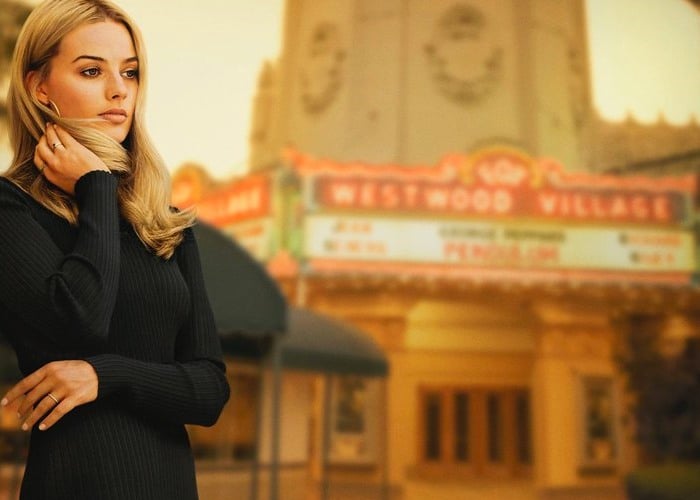This July, Quentin Tarantino will return to the silver screen with his next feature film, Once Upon a Time in Hollywood. The official synopsis reveals that the film will feature multiple storylines, the most prominent of which centers on television Western star Rick Dalton (Leonardo DiCaprio) and his longtime friend and stunt double, Cliff Booth (Brad Pitt), as they navigate a Hollywood that they no longer recognize. Back in July 2017, The Hollywood Reporter announced that Tarantino’s next film would focus on the Manson Murders, and while Dalton and Booth have taken center stage in the promotional materials, Manson’s shadow still looms large.
It is evident that Tarantino intends to rewrite and reimagine Hollywood history in this film, but the fact that it features fictionalized versions of real-life murderers and their victims raises the question of whether or not this will be exploitative. Based on the information currently available via promotional materials, Tarantino’s penchant for ironically stylized violence, and the manner in which he has reworked history in his previous films, it is likely that the Manson Murders will be depicted in gruesome, exploitative detail.
The cast list includes Charles Manson (Damon Herriman) along with members of his “Family” such as Lynette “Squeaky” Fromme (Dakota Fanning), Catherine Share (Lena Dunham), and Charles “Tex” Watson (Austin Butler). Margot Robbie will portray Sharon Tate, perhaps Manson’s most famous victim, and Robbie revealed on her Instagram that the film will take place in summer 1969, the summer that Tate and at least seven other people were brutally murdered by the Manson Family.
In Inglorious Basterds (2009), Tarantino reworks World War II with the fictionalized band of soldiers (the Basterds) who spread fear and shame among Nazis by violently scalping them or carving swastikas in their foreheads. Django Unchained takes place in the late 1850’s, yet plays like a highly stylized Spaghetti Western with its quick-paced editing and endless shootouts and showdowns. Tarantino’s films are characterized by their revisionist histories and exaggerated, stylized depictions of violence, but because Once Upon a Time in Hollywood depicts real people and events, these tendencies raise ethical questions.
This film presents an opportunity to humanize Sharon Tate and her friends Jay Sebring (Emile Hirsch), Abigail Folger (Samantha Robinson), and Wojciech Frykowski (Costa Ronin), to explore their lives and careers separate from their associations with Manson and the tragic ways in which they died. In Tarantino’s fictionalized world, Tate is Dalton’s next-door neighbor, and a less salacious reimagining of history could feature Dalton and Booth getting to know Tate and to learn about youth culture, style, and the New Hollywood from their proximity to her and her hip friends.
Dalton and Booth belong to the era of studio genre pictures, often dubbed Hollywood’s “Golden Age,” when the major production companies churned out hundreds of movies a year and audiences flocked to theaters to see them. By the end of the 1960s, the industry was indeed changing. Violent, stylish, and philosophical movies such as The Graduate, Bonnie and Clyde, and Easy Rider were in vogue, and studio epics, musicals, and Westerns were out. Youthful characters such as Tate and Hollywood hairdresser Jay Sebring could offer guidance to Dalton and Booth as they navigate the industry they no longer recognize.
It is not yet clear how much of a role Manson and his Family will play in the film, or exactly how central their brutalization of Tate and her friends will be to the narrative. The trailer only features one shot of the scruffy, smiling Manson approaching the camera, and another depicting a group of smiling hippie children walking in the late afternoon sunlight, who may or may not be the Manson Family. The fact that very little information has been revealed only strengthens curiosity audiences may have regarding the depiction of these salacious, violent events.
It has not yet been revealed whether the film’s multiple storylines will intersect, or whether Dalton and Booth will have anything to do with the events that took place at 1050 Cielo Drive in August 1969, but the fact that they are Tate’s neighbors indicate that they will likely hear or see something suspicious or become witnesses to these crimes, a reworking of history that could seem disrespectful. Depicting the murders in any way, whether in excruciatingly specific detail, or worse, in an exorbitantly stylized manner, will feel unnecessary and excessive.
This is not to say that the murders should be avoided altogether. The Manson Murders were a very real tragedy that played an important part in Hollywood history, yet it seems that the only way to avoid a fictionalized and exploitative retelling is to keep the violence offscreen. The brutalization inflicted upon the 8-months pregnant Tate, along with her friends who were present in the house at the time, is unconscionable and need not be recreated for entertainment. A discussion or description of the murders could be just as effective in getting across the message of how terrible it truly was, without displaying gruesome images of the crime scene.
With Once Upon a Time in Hollywood, Tarantino will retell history by delving into the rich cultural history of Hollywood in the 1960s. While any fictionalization of historical events and people will be slightly exaggerated and embellished, it feels disrespectful and exploitative to depict something as tragic as the Manson Murders, whether Tarantino decides to rework and reimagine these events in his own way or stick to a historically accurate retelling. We will have to wait until July to know for sure how this film will unfold, but it will always remain true that revising history is a dangerous and delicate task.

